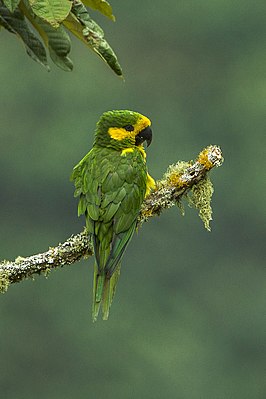Yellow-eared Parakeet
| Yellow-eared Parakeet | ||||||||||||
|---|---|---|---|---|---|---|---|---|---|---|---|---|

Yellow-eared Parakeet ( Ognorhynchus icterotis ) |
||||||||||||
| Systematics | ||||||||||||
|
||||||||||||
| Scientific name of the genus | ||||||||||||
| Ognorhynchus | ||||||||||||
| Bonaparte , 1857 | ||||||||||||
| Scientific name of the species | ||||||||||||
| Ognorhynchus icterotis | ||||||||||||
| ( Masséna & Souancé , 1854) |
The yellow-eared parrot ( Ognorhynchus icterotis ) is a rare species of parrot from the monotypic genus Ognorhynchus . It occurs in Colombia and Ecuador .
features
The parakeet reaches a size of 42 centimeters. Its habit is ara-like . The forehead, reins, upper cheeks and ear covers are yellow. In some copies, the ear covers are somewhat elongated. The lower cheeks and throat are green. The upper part of the head, chest, abdomen and under wing coverts are yellowish-green. The underside of the wings is dark yellow. The underside of the tail feathers is dull reddish brown. The beak is black. A bare, black eye ring runs around the orange-colored iris, which widens under the eye. The feet are gray. The juvenile birds look similar to the adult birds. However, the head plumage is more olive yellow and the tail is shorter. The vocalizations of the parakeet consist of two-syllable, goose-like calls.
habitat
The yellow-headed parakeet lives in mountain forests and their edges, partly cleared woodland, wooded areas at the tree line and stone beef forests in the temperate zone at altitudes between 2,000 and 3,400 meters. Occasionally it hikes down to 1,300 meters. The parakeet is dependent on habitats with the Quindio wax palm ( Ceroxylon quindiuense ).
Way of life
The Yellow-eared Parakeet is usually observed individually, in pairs or in small schools of 25 individuals. In the past there were even larger accumulations in the wax palm groves. Although the majority of the population is currently only found in one location, other swarms undertake seasonal migrations while foraging. The diet consists mainly of the bark, buds and fruits of the Quindio wax palm. Occasionally it also switches to other tree genera, including Citharexylon , Podocarpus and Sapium . There are two breeding cycles between April and November. The nest is built in a tree hollow at a height of about 25 meters in a wax palm. During the rearing of the young, the breeding pair is supported by other Yellow-eared Parakeets.
Danger
The Yellow-eared Parakeet was once common in all three Andean regions of Colombia and Ecuador. After a last sighting of 25 specimens on the slopes of Cerro Munchique in July 1978, it was considered lost for a long time until two small swarms were sighted in Colombia in 1995. In Ecuador there have been unconfirmed sightings from the Valle de Intag since 2000. The main threats are large-scale loss of habitat and overhunting. 90 to 93 percent of the mountain forests in its entire range in Colombia are fragmented. However, some larger forest areas have been preserved in its original range, so that other causes are also responsible for its decline. The mortality of the wax palms is very high and there are hardly any young palms because the cattle eat the seedlings. In addition, the logging in the adjacent areas increases the susceptibility of the palms to diseases. Wax palms live for over 500 years and grow very slowly. This palm species is used excessively for Palm Sunday ceremonies throughout the range of the Yellow-eared Parakeet. In Ecuador, the Yellow-eared Parakeet was heavily hunted for its meat, and catches for the pet trade also had an impact on population development, although this species is difficult to keep in human care.
Protective measures
In 1998 ornithologists and conservationists Niels Krabbe and Paul Salaman founded the “Projeto Ognorhynchus”. After several months of field work, a population of 61 yellow-winged parakeets was observed in the "Central Cordillera" of Colombia in April 1999. Another 20 specimens had been sighted by September 1999. Thanks to conservation projects in which the organizations Fundación ProAves, Loro Parque Fundación , American Bird Conservancy, Corantioquia, the Zoological Society for Species and Population Conservation and the Fund for Endangered Parrots were involved, and promises by the guerrillas not to hinder the conservationists in their work , the population of the Yellow-winged Parakeet in Colombia increased to 600 by 2005. In 2008 there were 203 fledglings in 80 monitored nests.
literature
- Joseph Michael Forshaw: Parrots of the World - An Identification Guide . Princeton University Press, Princeton 2006, ISBN 978-0-691-09251-5 .
- Del Hoyo, J., Elliot, A. & Sargatal, J. (Editors) (1997). Handbook of the Birds of the World. Volume 4: Sandgrouse to Cuckoos. Lynx Edicions. ISBN 84-87334-22-9
- Steven L. Hilty , William L. Brown: A guide to the birds of Colombia. Princeton University Press, 1986, ISBN 978-0-691-08372-8 .
Web links
- BirdLife species factsheet
- Yellow-eared Parakeet
- The Yellow-eared Parakeet (Ognorhynchus icterotis) in Colombia Annual Report 1998
- Yellow-eared Parakeet - The Parrot and the Palm
- Ognorhynchus icterotis inthe IUCN 2013 Red List of Threatened Species . Listed by: BirdLife International, 2012. Retrieved September 26, 2013.